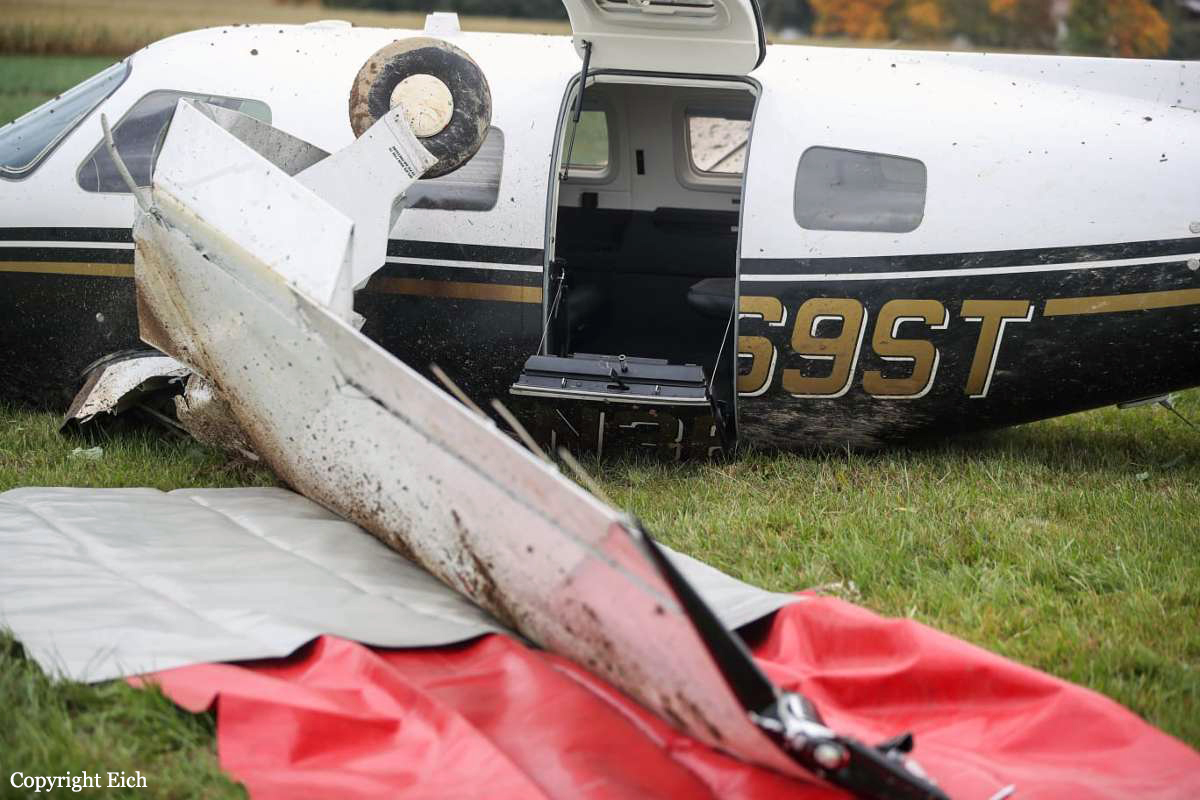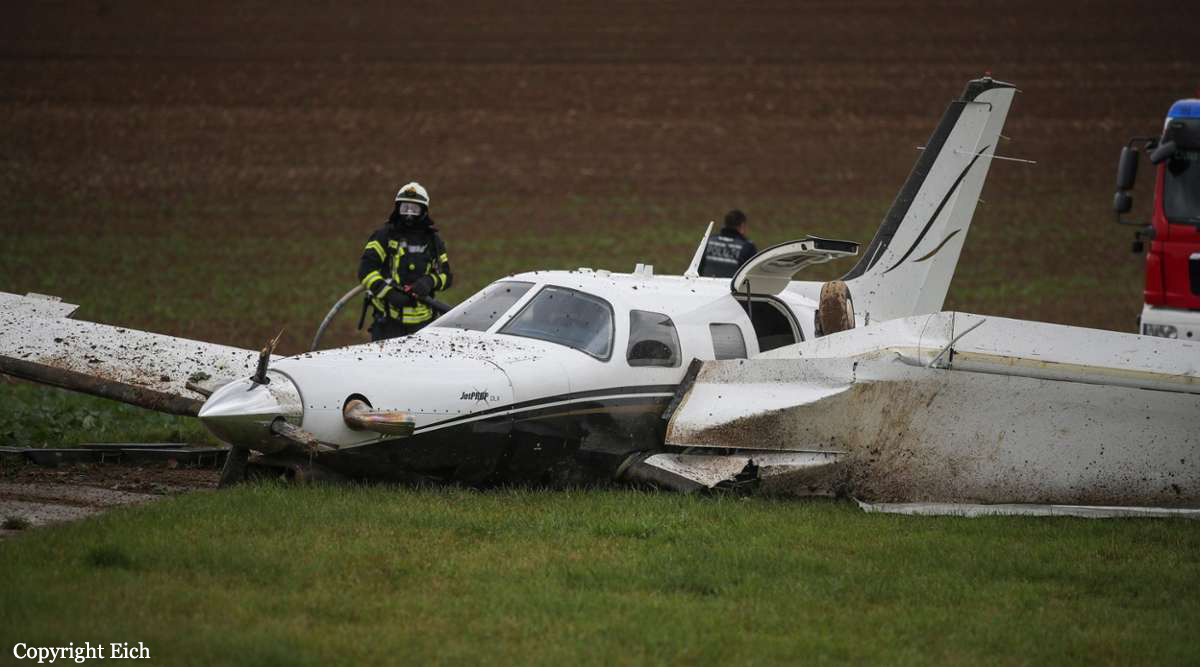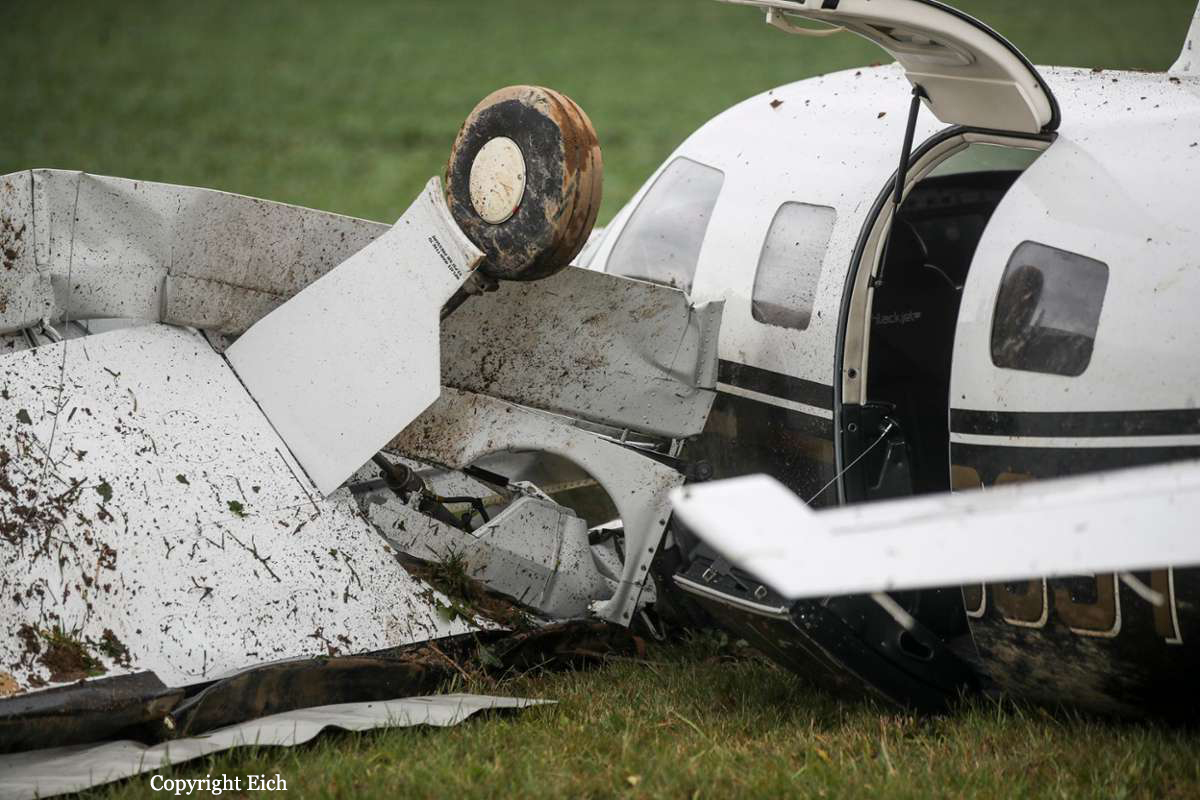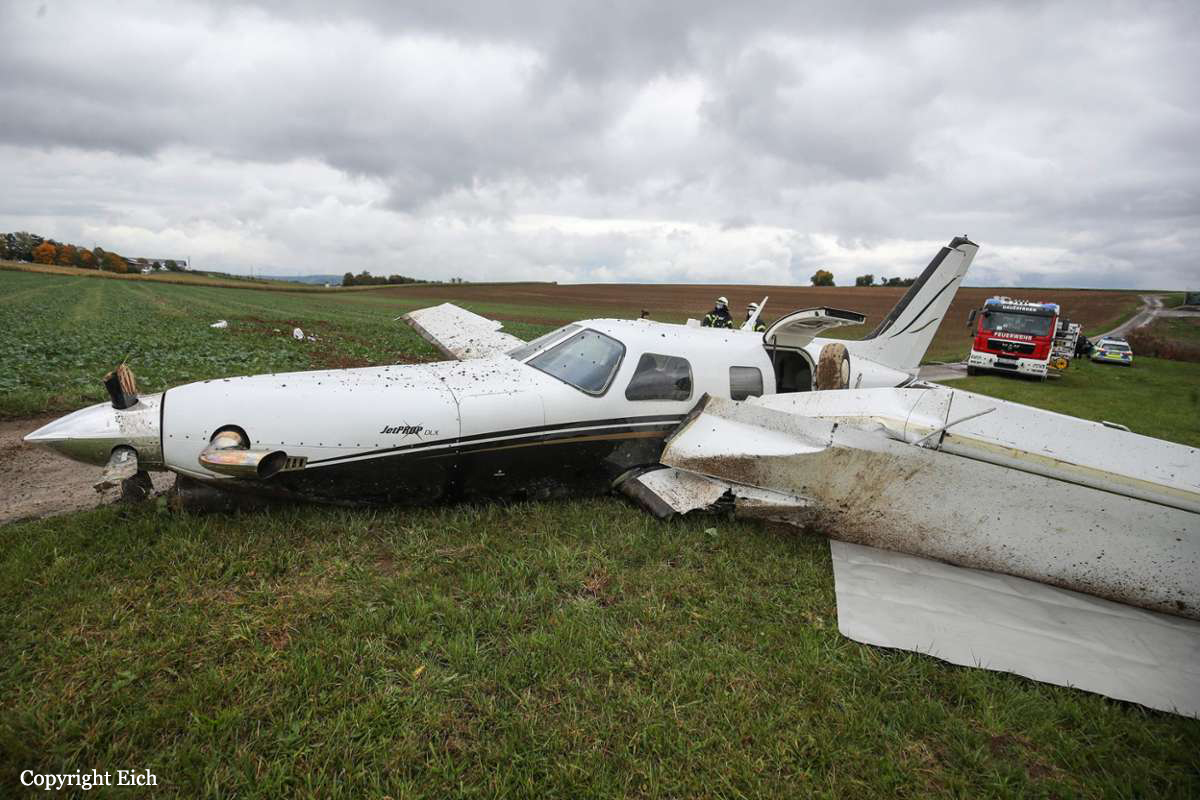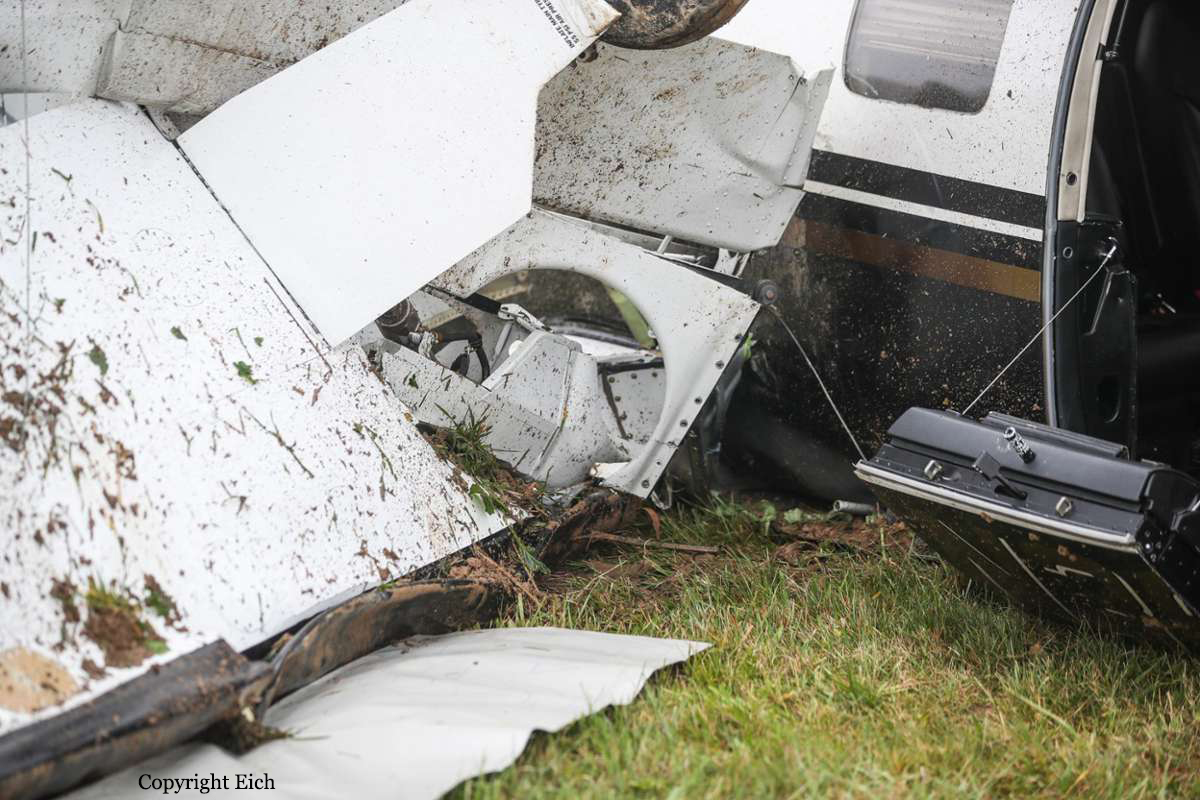Country
Crash of a Piper PA-46-350P Malibu Mirage in Cranfield
Date & Time:
Apr 29, 2021 at 1425 LT
Registration:
G-HYZA
Survivors:
Yes
Schedule:
Cranfield - Cranfield
MSN:
46-36130
YOM:
1997
Flight number:
86
Crew on board:
2
Crew fatalities:
Pax on board:
0
Pax fatalities:
Other fatalities:
Total fatalities:
0
Captain / Total hours on type:
1588.00
Circumstances:
On the morning of the accident flight, G-HYZA was flown for approximately 16 minutes on test flight 85. The flight test team debriefed the results and prepared the aircraft for flight 86. The plan for this flight was for the HV battery to be switched off at the end of the downwind leg then, if able, to fly three or more circuits at 1,000 ft aal using the HFC only to provide electrical power. The flight test team discussed experimenting with combinations of higher airspeeds and propeller rpm that would reduce the aircraft angle of attack and improve the mass flow of air through the radiator which provided cooling for the HFC. This was considered as a potential strategy to manage a slow rise in temperature in the HFC which they had observed in previous flights when flying on that power source alone. The test card for flight 86 was not amended to reflect this intention. At 1406 hrs, following a normal start using both the HV battery and HFC to provide electrical power, the HV was switched off to preserve its electrical capacity. The aircraft taxied to the holding point and was cleared to line up on Runway 03. The weather was fair with good visibility and light winds from 010°. The aircraft entered the runway and backtracked to the threshold where the pilot commenced a run-up of the propulsion system to ensure the HFC could achieve thermal stability within the flight test parameters. Once the temperatures in the HFC were stable, the pilot switched on the HV battery to bring both power sources online and commenced the takeoff run. As the aircraft accelerated and the power lever was advanced, the observer operated the high temperature override switch to maintain the temperature of the HFC within the operating limits. After takeoff, the pilot turned onto the crosswind leg and climbed to the circuit height of 1,000 ft agl. During the downwind leg of the right-hand circuit, the pilot stated the power was set to 95 kW, the propeller to 2,500 rpm and the airspeed to 100 kt. Once stabilized at these parameters, which were at variance with the flight test card conditions, the observer confirmed that the HFC operating temperatures were within limits. He then instructed the pilot to reduce power to 90 kW to assess the effect on the airspeed, which reduced to approximately 95 kt. The pilot increased the power to 95 kW to regain the target speed. The pilot set the power by reference to his display unit which was located below the throttle quadrant. When he looked up from this task, he recognized that the aircraft was in a late downwind position. He turned onto base leg and commented that they were losing speed in the turn. The observer suggested that they could increase power to 120 kW to regain the lost airspeed, then reduce power before turning off the HV battery to re-establish the test conditions. He also suggested a reduction in propeller rpm. The pilot increased power to 120 kW but did not reduce the propeller rpm. As he started to turn onto final, the pilot briefed that once he had established straight and level flight he would reduce the power slightly and turn off the HV battery leaving the electrical motors powered by the HFC. He called final on the radio and was cleared by ATC to fly through at circuit height. Approaching the runway threshold at approximately 940 ft agl, the pilot reduced power to 90 kW, set the airspeed to 90 kt then selected the HV battery to off. Immediately, all electrical drive to the propeller was lost. The pilot and observer made several unsuccessful attempts to reset the system to restore power from the HFC with the observer stating the action to be taken and the pilot making the switch selection. The observer instructed the pilot to select the HV battery to on to reconnect the alternative power source. HV power was not restored so the observer instructed the pilot to attempt a system reset with the HFC in the off position. Electrical power was still not restored and at 440 ft agl the observer declared “the voltage is too high”, to which the pilot replied, “we’ve got to do something quick”. The observer called for a further reset attempt and adjusted the power lever. The aircraft had now travelled the length of the runway and was at approximately 320 ft aal when the observer reported that power could not be restored. The pilot transmitted a MAYDAY call and initiated a turn to the left to position for a landing on Runway 21. Almost immediately he recognized that he did not have sufficient height to complete the manoeuvre so lowered the landing gear and selected full flap for a forced landing in a field that was now directly ahead on a north-westerly heading. The aircraft touched down at approximately 87 kt ground speed on a level grass field. The pilot applied the brakes, and the aircraft continued its movement until it struck, and passed through, a hedge during which the left wing broke away. The nosewheel and left main wheel entered a ditch and the aircraft came to an abrupt stop. The pilot and observer were uninjured and exited the aircraft through the upper half of the cabin door. The airport fire service arrived quickly at the scene. The observer returned to the aircraft and vented the hydrogen tank to atmosphere and disconnected the HV battery to make the aircraft safe.
Probable cause:
The loss of power occurred during an interruption of the power supply when, as part of the test procedure, the battery was selected off with the intention of leaving the electrical motors solely powered by the hydrogen fuel cell. During this interruption the windmilling propeller generated a voltage high enough to operate the inverter protection system, which locked out the power to the motors. The pilot and observer were unable to reset the system and restore electrical power.
Final Report:

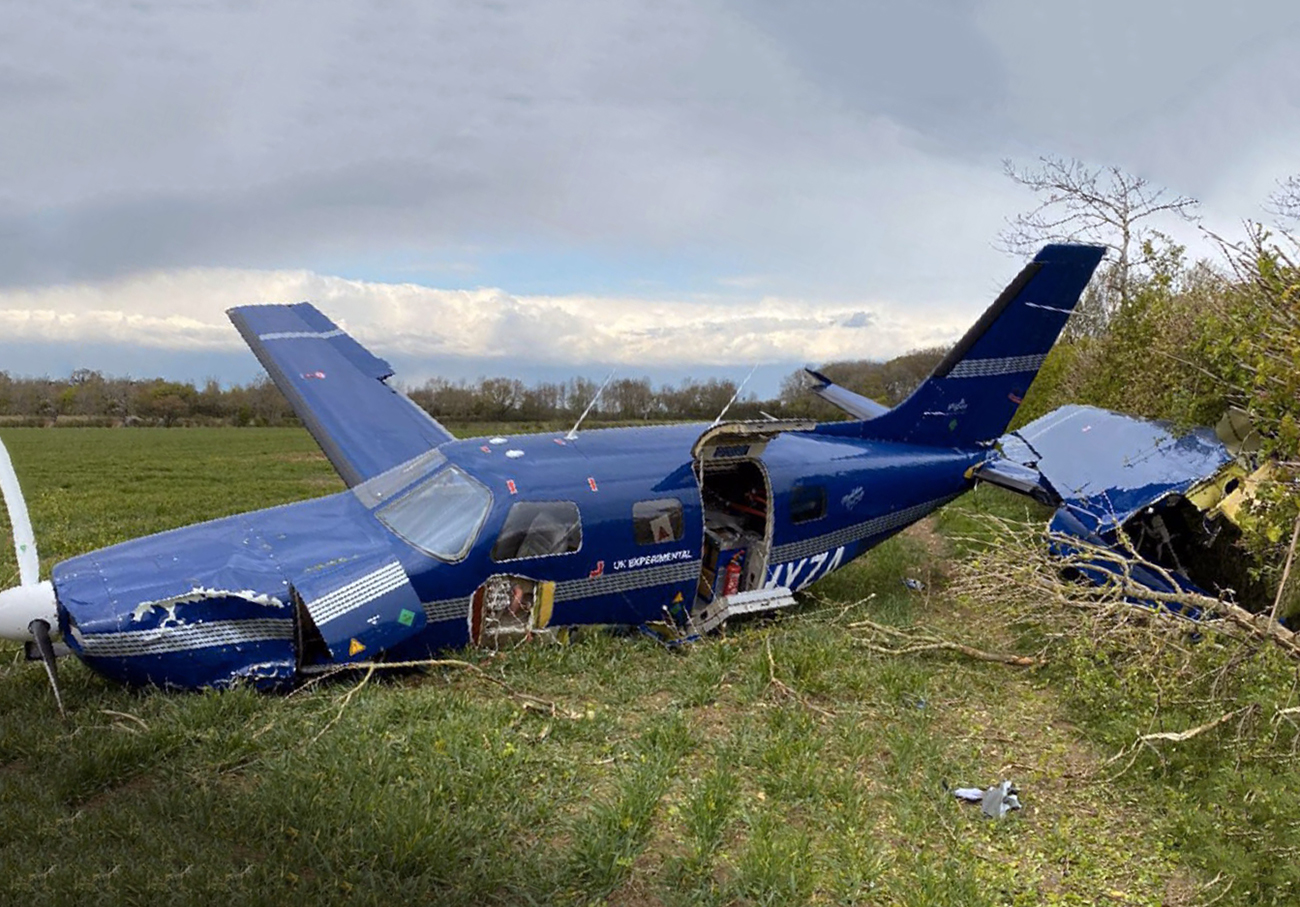
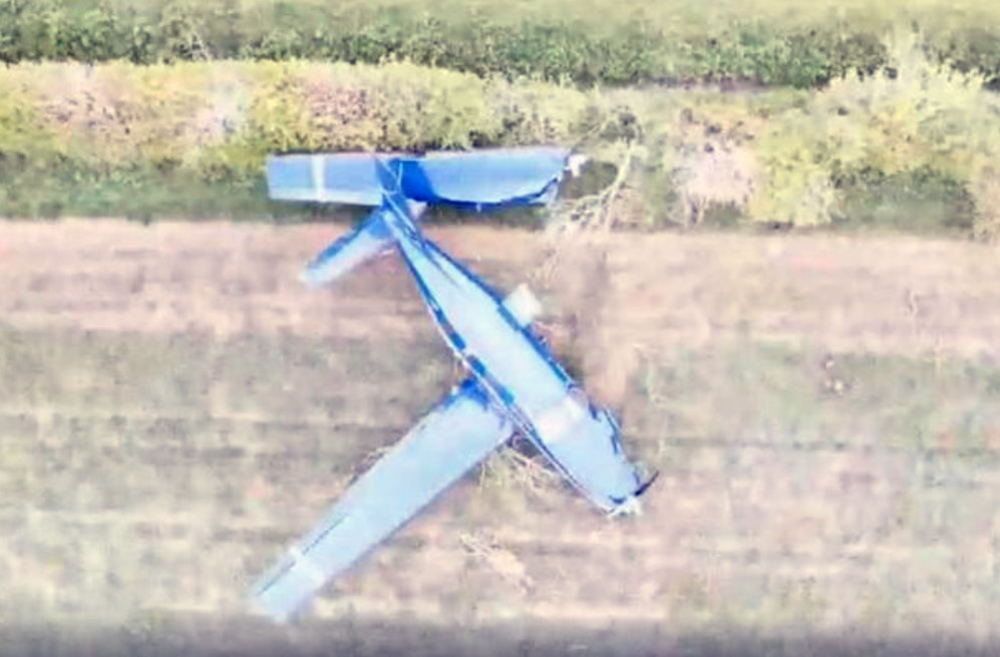
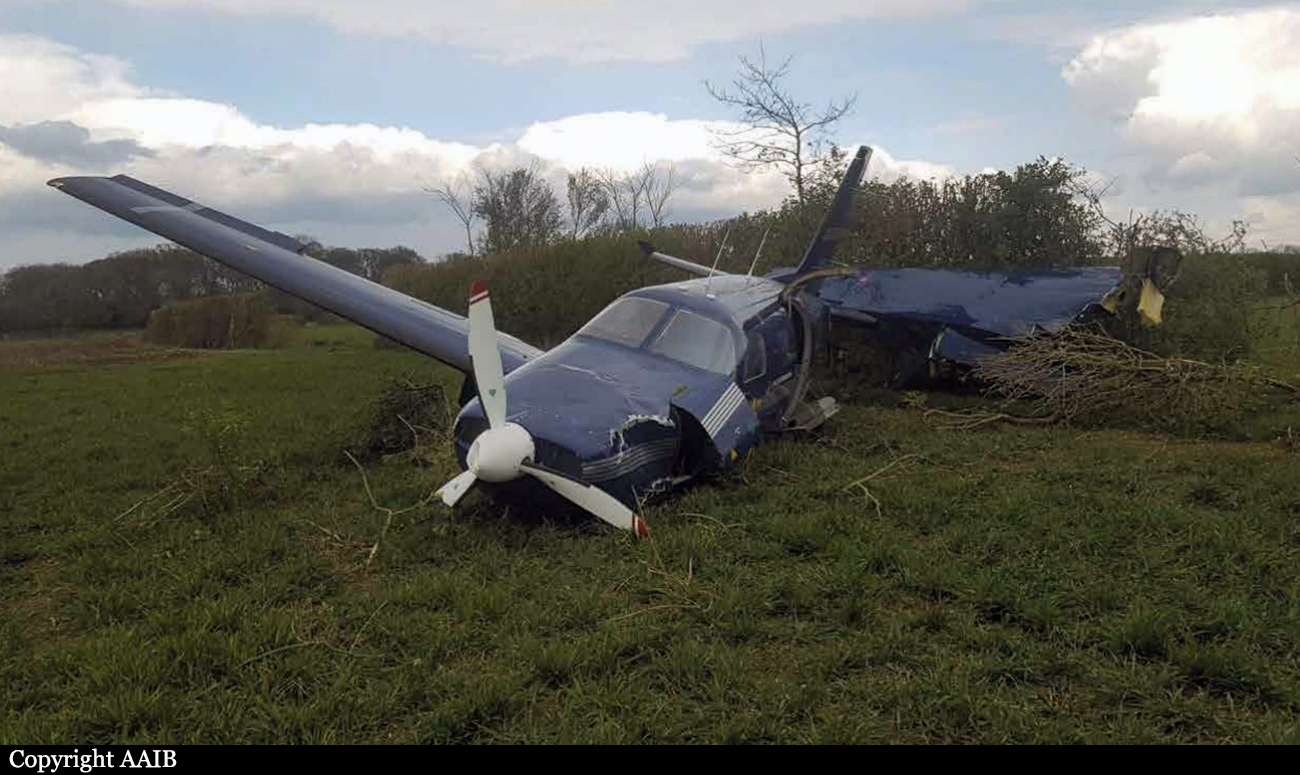
Crash of a Piper PA-46-310P Malibu in Danville: 4 killed
Date & Time:
Apr 23, 2021 at 1701 LT
Registration:
N461DK
Survivors:
No
Schedule:
Muskogee – Williston
MSN:
46-8508102
YOM:
1985
Crew on board:
1
Crew fatalities:
Pax on board:
3
Pax fatalities:
Other fatalities:
Total fatalities:
4
Circumstances:
The pilot was conducting an instrument flight rules cross-country flight and climbing to a planned altitude of 23,000 ft mean sea level (msl). According to air traffic control data, as the airplane climbed through 18,600 ft msl, its groundspeed was 171 knots, and a gradual reduction in groundspeed began. After reaching an altitude of about 20,200 ft msl, the airplane began a descent on a southeast heading. Just before the descent began, the airplane’s groundspeed had decreased to 145 knots. About 2 minutes after the descent began, the airplane turned right to a northeast heading on which it continued for about 30 seconds. The flightpath then became erratic before the data ended. The pilot made no distress calls and did not respond to repeated calls from the controller. The main wreckage of the airplane was located in densely forested terrain at an elevation of about 930 ft about 1,000 ft south of the last radar return. The outboard portion of the right wing, right aileron, right horizontal stabilizer, and right elevator were not located with the main wreckage and, despite ground and aerial searches with a small unmanned aircraft system, were not found. Examination of the wreckage indicated that the missing wing and tail sections separated in flight due to overload. Examination of the recovered airframe and engine did not reveal evidence of any pre-existing mechanical malfunctions or anomalies that would have precluded normal operation. Weather forecasts indicated that the accident site was in an area where moderate icing conditions up to 25,000 ft msl, embedded thunderstorms, and 2-inch hail were forecasted. Review of preflight weather information received by the pilot indicated that he was aware of the conditions forecast on the route of flight before initiating the flight. Meteorological data revealed that the airplane likely entered icing conditions that ranged from light to heavy as it climbed through 14,000 ft msl about 23 minutes after takeoff and remained in icing conditions for the remaining 16-minute duration of the flight. Freezing drizzle conditions were likely present along the flightpath. Although the airplane was equipped for flight in icing conditions, the pilot’s operating handbook contained a warning about flight into severe icing conditions, which stated that flight in freezing drizzle could result in ice build-up on protected surfaces exceeding the capability of the ice protection system. The airplane’s gradual loss of groundspeed as it climbed was consistent with ice accumulating on the airplane. It is likely that during the 16 minutes the airplane was operating in icing conditions, the capability of the ice protection system was exceeded, which resulted in a degradation of aircraft performance and subsequent aerodynamic stall. During the ensuing uncontrolled descent, the structural capability of the airplane was exceeded, which resulted in an inflight break up. A review of the pilot’s records revealed multiple certificate application failures for reasons that included inadequate knowledge of cross-country flight planning, aircraft performance, and stalls. Review of the pilot’s airman knowledge written tests found areas answered incorrectly over multiple exams included meteorology, aircraft performance, aeronautical decision-making, and stalls. The ethanol identified in the pilot’s cavity blood was most likely the result of postmortem production. Therefore, effects from ethanol did not play any role in this accident. The cargo was documented as it was removed from the airplane and remained secure until after it was weighed. Based upon the weight of the cargo, passengers, airplane, and fuel from the filed flight plan, at the time of departure, the airplane would have been about 361 lbs over maximum gross weight. According to the FAA Pilot’s Handbook of Aeronautical Knowledge, an overloaded airplane “may exhibit unexpected and unusually poor flight characteristics,” which include reduced maneuverability and an increased stall speed.
Probable cause:
The pilot’s improper decision to continue flight in an area of moderate-to-heavy icing conditions, which resulted in exceedance of the airplane’s anti-icing system capabilities, a degradation of aircraft performance, and subsequent aerodynamic stall.
Final Report:
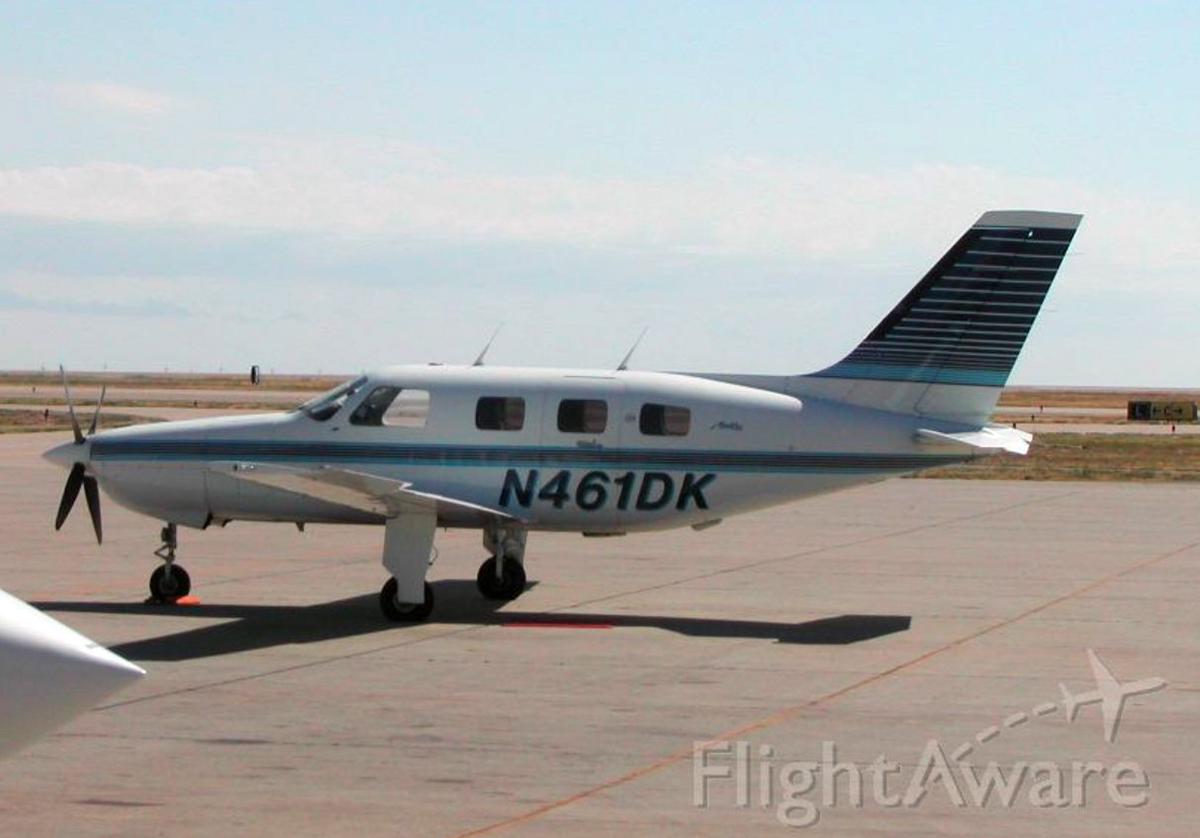



Crash of a Piper PA-46R-350T Matrix in Tehachapi: 1 killed
Date & Time:
Feb 13, 2021 at 1627 LT
Registration:
N40TS
Survivors:
No
Schedule:
Camarillo – Mammoth Lakes
MSN:
46-92156
YOM:
2010
Crew on board:
1
Crew fatalities:
Pax on board:
0
Pax fatalities:
Other fatalities:
Total fatalities:
1
Captain / Total hours on type:
63.00
Aircraft flight hours:
877
Circumstances:
The non-instrument-rated pilot departed on a cross-country flight. Radar track data revealed the airplane traveled on a relatively straight course to the northeast for about 32 minutes. Near the end of the flight track data, the track showed an increasingly tight left spiraling turn near the accident site. The airplane impacted steep sloping terrain, and a postimpact fire ensued. As a result of the impact, the airplane was segmented into several sections. Examination of the wreckage revealed no evidence of mechanical malfunction or failures that would have precluded normal operation. The attitude indicator instrument was disassembled, and the vacuum-powered rotor and housing revealed rotational scoring damage, indicating the instrument vacuum system was operational at the time of the accident. The investigation found no evidence indicating the pilot checked the weather or received weather information before departure. The surrounding weather reporting stations near the accident site reported wind conditions with peak gusts up to 47 knots around the time of the accident. The pilot likely encountered mountain wave activity with severe turbulence, which resulted in loss of control of the airplane and impact with terrain. Contributing to the accident was the pilot’s failure to obtain a preflight weather briefing, which would have alerted him to the presence of hazardous strong winds and turbulent conditions. Postmortem toxicology testing of the pilot’s lung and muscle tissue samples detected several substances that are mentally and physically impairing individually and even more so in combination for performing hazardous and complex tasks. However, blood concentrations are needed to determine the level of impairment, and no blood samples for the pilot were available. While the pilot was taking potentially impairing medications and likely had conditions that would influence decision making and reduce performance, without blood concentrations, it was not possible to determine whether the potentially impairing combination of medications degraded his ability to safely operate the airplane.
Probable cause:
The pilot’s encounter with mountain wave activity with severe turbulence, which resulted in a loss of airplane control. Contributing to the accident was the pilot’s failure to obtain a preflight
weather briefing.
weather briefing.
Final Report:


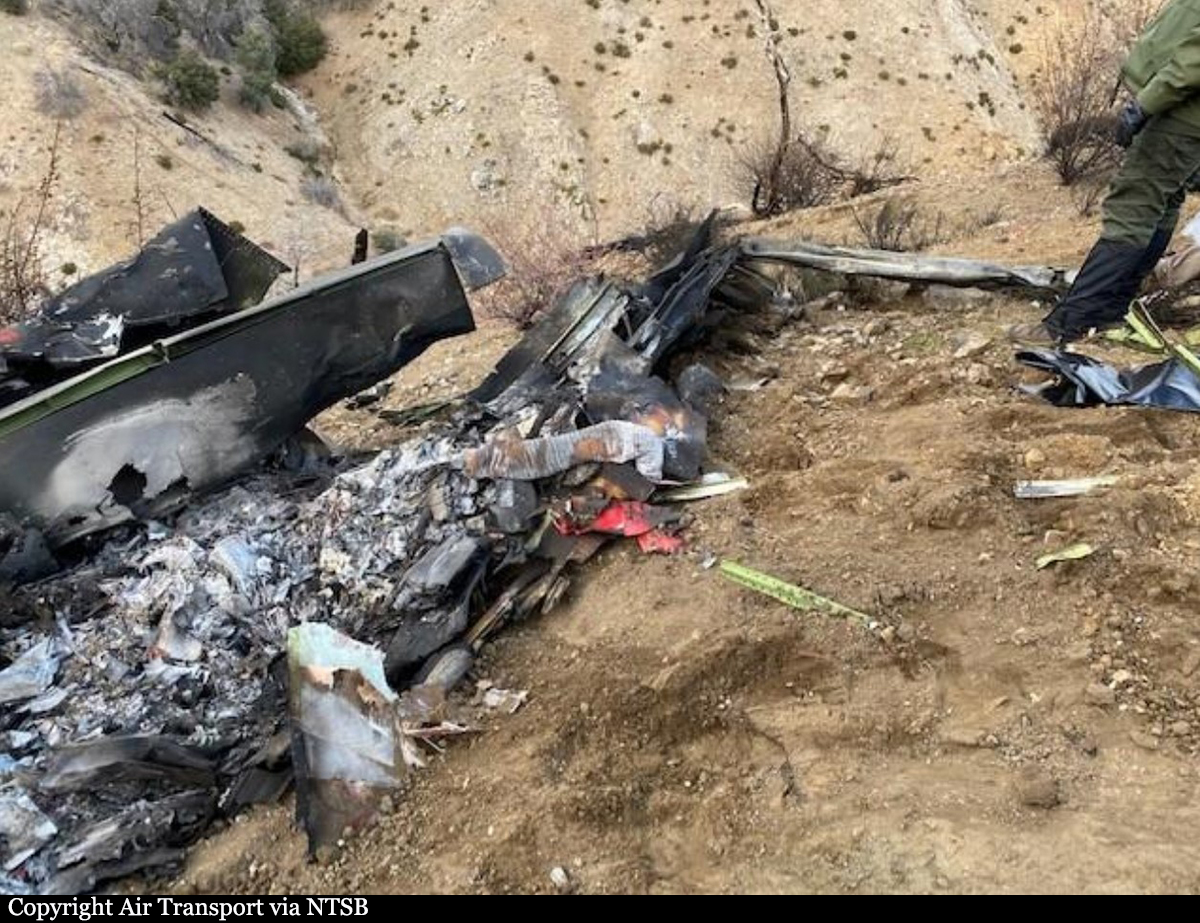

Crash of a Piper PA-46-350P Malibu Mirage in Worcester
Date & Time:
Feb 2, 2021 at 1655 LT
Registration:
N221ST
Survivors:
Yes
Schedule:
Martha’s Vineyard – Worcester
MSN:
46-36651
YOM:
2014
Crew on board:
1
Crew fatalities:
Pax on board:
2
Pax fatalities:
Other fatalities:
Total fatalities:
0
Circumstances:
The pilot reported that, while descending through clouds and beginning the instrument approach, some ice accumulated on the wings and he actuated the deice boots twice. The pilot saw the deice boots functioning normally on the wings and could not see the tail; however, the elevator began to shake, and he lost elevator control. The pilot applied forward pressure on the yoke and had to trim nose-down to avoid a stall. There were no cockpit caution indications and the pilot had disengaged the autopilot before descent. The airplane descended through the clouds and impacted a tree before coming to rest upright in a grass area. Postaccident examination of the wreckage, including component testing of the deice system, did not reveal any preimpact mechanical malfunctions. The flap jackscrew position suggested that the flaps were likely in transit between 0° and 10° flap extension at the time of impact. Review of radar data revealed that, during the 2 minutes before the accident, the airplane’s groundspeed averaged about 82 knots; or an approximate average airspeed of 94 knots when accounting for the winds aloft. Current weather observations and forecast weather products indicated that the airplane was likely operating in an area where moderate and potentially greater structural icing conditions prevailed, and where there was the potential for the presence of supercooled liquid droplets. Review of the pilot operating handbook for the airplane revealed that the minimum speed for flight in icing conditions was 130 knots indicated airspeed. It is likely that the pilot’s failure to maintain an appropriate speed for flight in icing conditions resulted in insufficient airflow over the ice contaminated elevator and the subsequent loss of elevator control.
Probable cause:
The pilot’s failure to maintain the minimum airspeed for flight in icing conditions, which resulted in a loss of elevator control during approach due to ice accumulation.
Final Report:
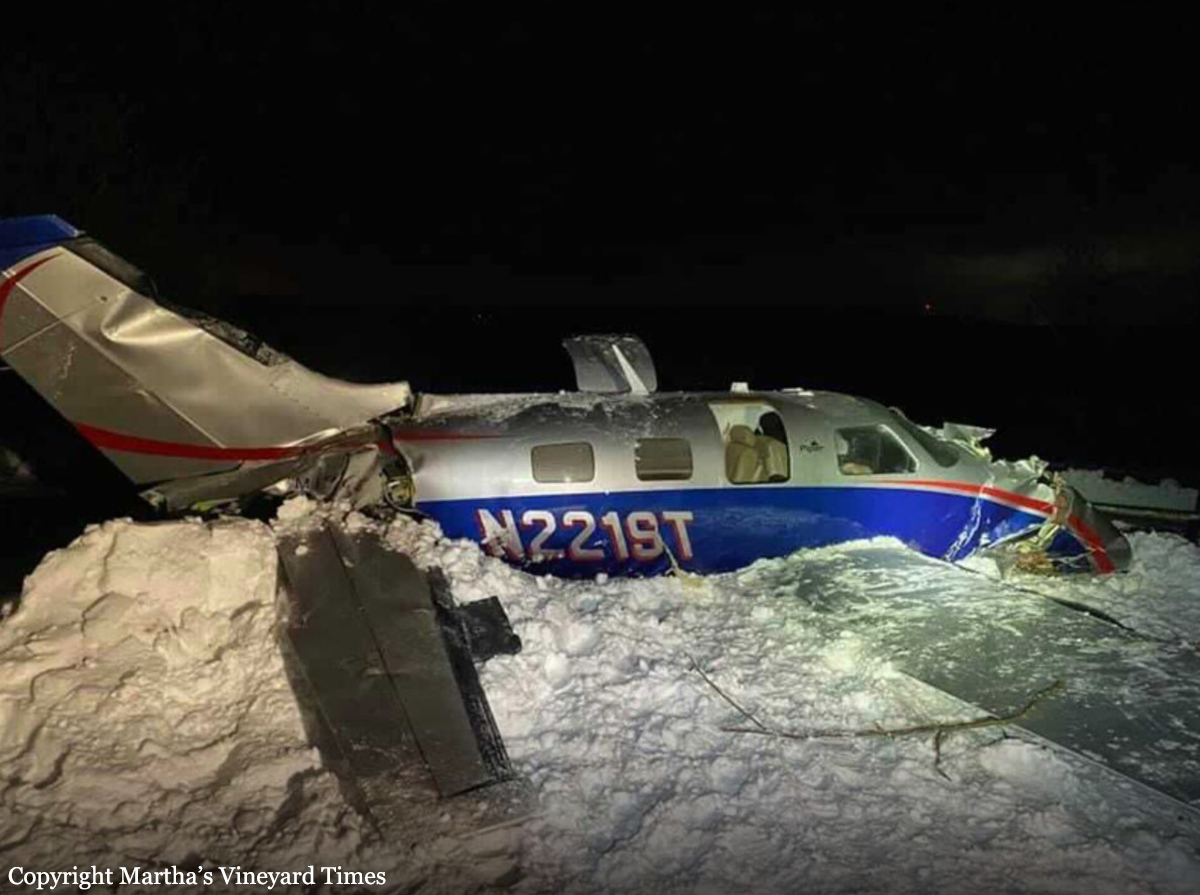

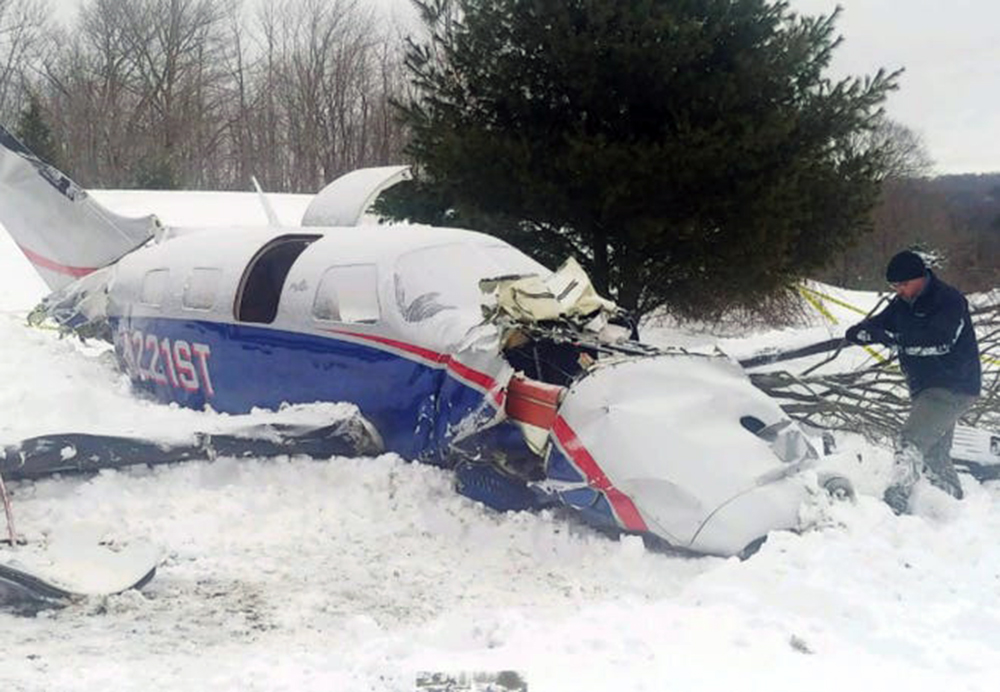
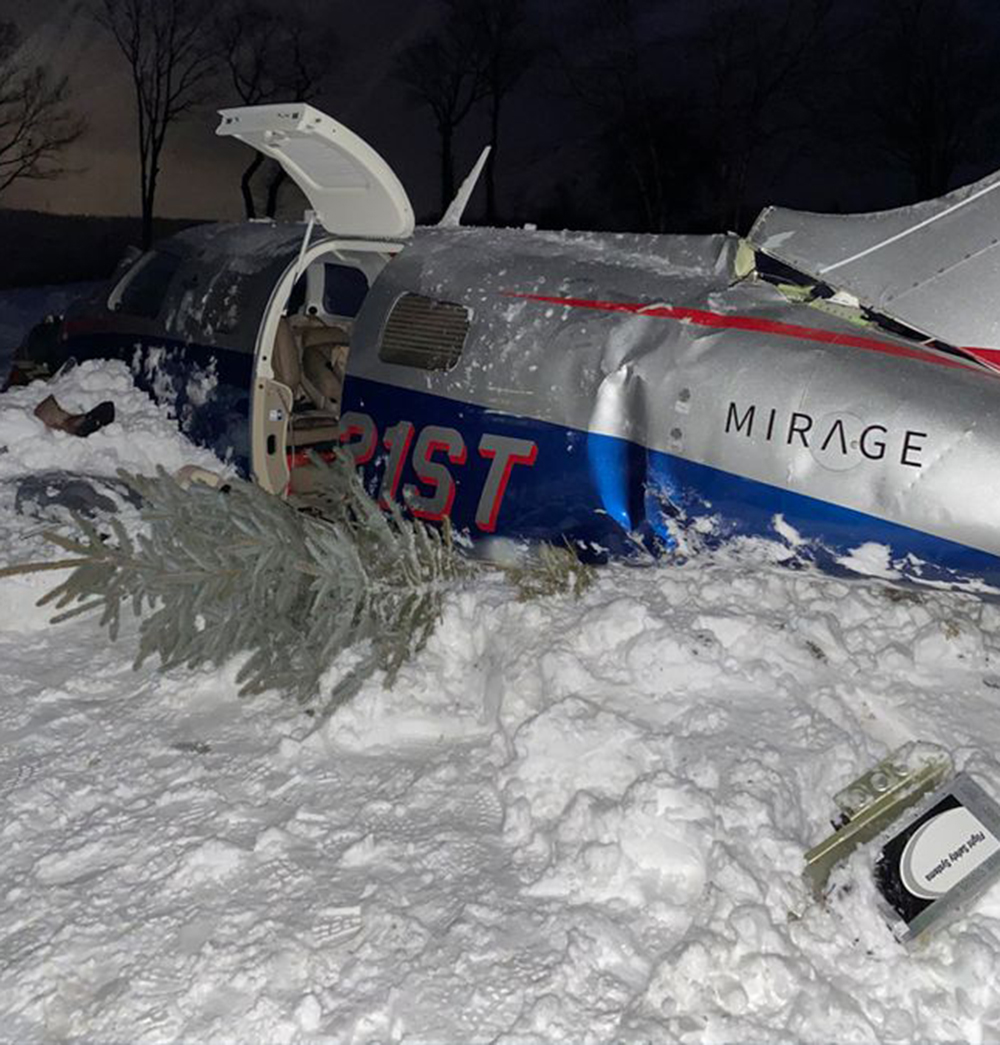

Crash of a Piper PA-46-310P Malibu off Naples
Date & Time:
Dec 19, 2020 at 1216 LT
Registration:
N662TC
Survivors:
Yes
Schedule:
Sarasota - Key West
MSN:
46-8508095
YOM:
1985
Crew on board:
1
Crew fatalities:
Pax on board:
1
Pax fatalities:
Other fatalities:
Total fatalities:
0
Captain / Total hours on type:
890.00
Aircraft flight hours:
3462
Circumstances:
After takeoff from his home airport with about 50 gallons of fuel in each fuel tank, the pilot climbed to 7,000 ft and proceeded to his destination. When he was about halfway there, he switched from the right fuel tank to the left fuel tank. Immediately after switching fuel tanks, the engine started to sputter and lost power. The pilot switched back to the right fuel tank but there was no change. He then tried different power settings, adjusted the mixture to full rich and switched tanks again without regaining engine power. The pilot advised air traffic control (ATC) that he was having an engine problem and needed to land at the nearest airport. ATC instructed him contact the control tower at the nearest airport and cleared him to land. The pilot advised the controller that he was not going to be able to make it to the airport and that he was going to land in the water. During the water landing, the airplane came to a sudden stop. The pilot and his passenger then egressed, and the airplane sank. An annual inspection of the airplane had been completed about 2 months prior to the accident and test flights associated with the annual inspection had all been done with the fuel selector selected to the right fuel tank, and this was the first time he had selected the left fuel tank since before the annual inspection. The airplane was equipped with an engine monitor that was capable of recording engine parameters. Examination of the data revealed that around the time of the loss of engine power, exhaust gas temperature and cylinder head temperature experienced a rapid decrease on all cylinders along with a rapid decrease of turbine inlet temperature, which was indicative of the engine being starved of fuel. Examination of the wreckage did not reveal any evidence of any preimpact failures or malfunctions of the airplane or engine that would have precluded normal operation. During examination of the fuel system, the fuel selector was observed in the RIGHT fuel tank position and was confirmed to be in the right fuel tank position with low pressure air. However, when the fuel selector was positioned to the LEFT fuel tank position, continuity could not be established with low pressure air. Further examination revealed that a fuel selector valve labeled FERRY TANK was installed in the left fuel line between the factory-installed fuel selector and the left fuel tank. The ferry tank fuel selector was observed to be in the ON position, which blocked continuity from the left fuel tank to the engine. Continuity could only be established when the ferry tank fuel selector was positioned to the OFF position. With low pressure air, no continuity could be established from the ferry tank fuel line that attached to the ferry tank’s fuel selector. The ferry tank fuel selector valve was mounted between the pilot and copilot seats on the forward side of the main wing spar in the area where the pilot and copilot would normally enter and exit the cockpit. This location was such that the selector handle could easily be inadvertently kicked or moved by a person or object. A guard was not installed over the ferry tank fuel selector valve nor was the selector valve handle safety wired in the OFF position to deactivate the valve even though a ferry tank was not installed. Review of the airplane’s history revealed that about 3 years before the accident, the airplane had been used for an around-the-world flight by the pilot and that prior to the flight, a ferry tank had been installed. A review of maintenance records did not reveal any logbook entries or associated paperwork for the ferry tank installation and/or removal, except for a copy of the one-page fuel system schematic from the maintenance manual with a handwritten annotation (“Tank”), and hand drawn lines, both added to it in blue ink. A review of Federal Aviation Administration records did not reveal any record of a FAA Form 337 (Major Repair or Alteration) or a supplemental type certificate for installation of the ferry tank or the modification to the fuel system.
Probable cause:
The inadvertent activation of the unguarded ferry tank fuel selector valve, which resulted in fuel starvation and a total loss of engine power.
Final Report:

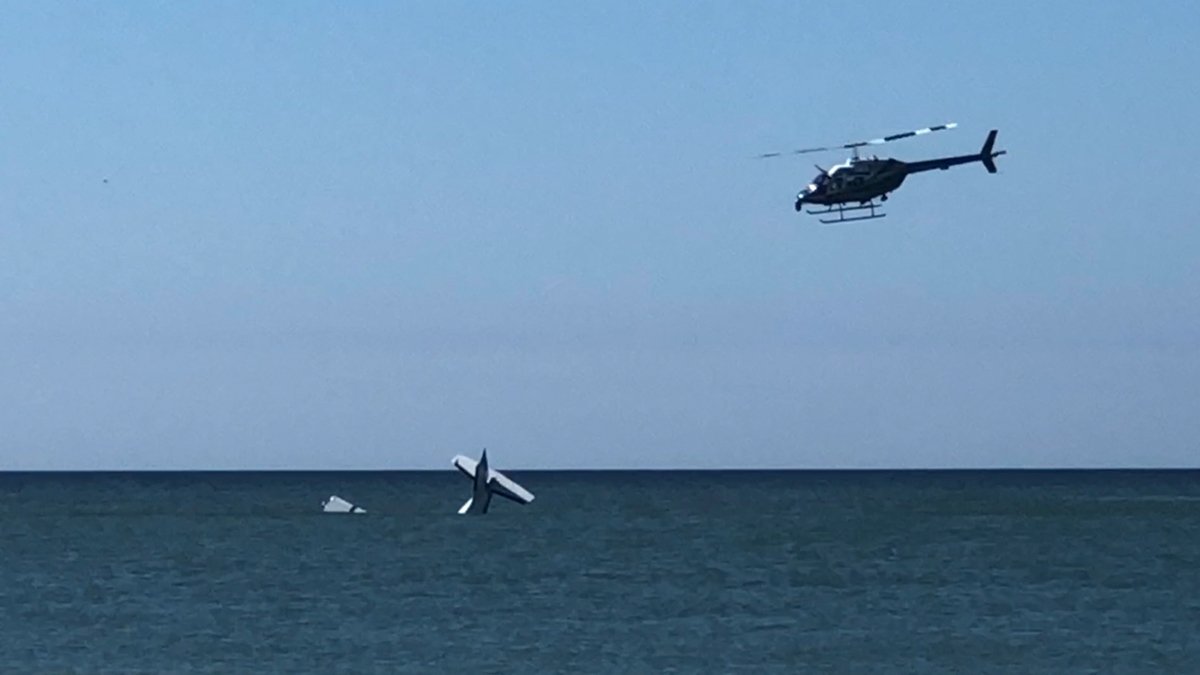




Crash of a Piper PA-46-350P Malibu Mirage in Dauchingen
Date & Time:
Oct 10, 2020 at 1100 LT
Registration:
N369ST
Survivors:
Yes
Schedule:
Rottweil - Lugano
MSN:
46-36936
YOM:
2006
Crew on board:
1
Crew fatalities:
Pax on board:
1
Pax fatalities:
Other fatalities:
Total fatalities:
0
Circumstances:
After takeoff from Rottweil-Zepfenhan Airport, while climbing, the crew encountered technical problems. The pilot reduced his altitude and attempted an emergency landing in an open field located in Dauchingen, about 15 km southwest of Rottweil Airport. The aircraft landed gear down but and eventually came to rest on a path with its undercarriage and both wings partially torn off. Both occupants were slightly injured.


